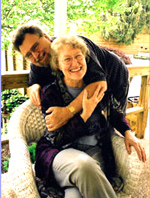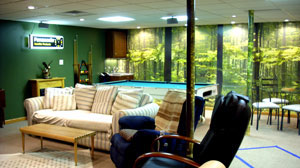Thank you, Dr. Rosner . . .
September 1, 2007
 |
"Thank you, Dr. Rosner, for going the distance with me when no one else had invited me back for check ups or continued tests."
|
My wife, Connie, and I retired to Weaverville in Western North Carolina from Northern New Jersey in the late fall of 2003. I was approaching 62 years of age. I had felt fine except for having previous complaints at my employment of growing tired . . . complaints that had gone back to the mid 1990’s when I found my enthusiasm starting to wane.
In the spring of April 2005, I suddenly began to have unexpected heavy breathing episodes while mowing the lawn. Before long I couldn't complete this weekly job, as I'd always been able to do.
Within weeks I had to take several breaks, sitting in a chair on the front porch breathing so hard a neighbor wanted to call an ambulance. The ache in my lungs was followed by a coolness on my chest, quickly followed by a feeling of hundreds of needles. Then nausea set in, once throwing up violently because I wouldn’t stop walking behind the mower. I finally bought a ride-on mower, but still had trouble walking behind the power mower to finish up where the larger ride-on couldn’t reach.
I had noticed during the same period that my right leg was growing weak and that the skin over it tingled at times. Once my leg refused to cooperate when I was walking up a front step. I also had the feeling of “bubbles moving in chest,” discovering after buying a blood pressure monitor that this was tied to a low heart rate, which sometimes in the middle of the night showed below 38 bpm on the machine or just reading “low.” For years in New Jersey, I'd also had trouble standing on one foot and couldn't squat down. I had attributed this to my being a bit overweight while approaching 60-years of age.
On an early morning, I believe in July of 2005, I awoke with chest pains and chalky colored skin. The local family clinic sent me by ambulance to the emergency room at Mission Hospital. From there I was assigned to a heart specialist, a pulmonary specialist, and later a neuromuscular specialist. By November I'd had a complete battery of tests with doctors finding nothing wrong. One doctor had suggested it could be psychological, but doubted it. Another thought it was an early sign of ALS. To say the least, it was troubling in what was supposed to be the Golden Years. Mine, I had thought, had become the color of rust.
With no future appointments set up by my specialists and my problem continuing into 2006, my primary physician, who had not abandoned me, arranged to send me to the pulmonary department at the University of North Carolina in Chapel Hill. After several three-hour trips over a five-month period nuclear tests with 3-D images diagnosed me with weakening lung muscles. My pulmonary visits ended in January 2007.
So I had come to a dead end in the road. That is, until I had a leak in my roof.
A local roofer had installed a new roof on our home the previous year, and after a heavy rain in the fall of 2006 the ceiling below a skylight looked a bit discolored. The roofer was an ox of a man, who had trouble with uncontrolled rapid eye movement. But this second meeting disturbed me because his arms were shaking almost uncontrollably.
He asked me, "What's wrong with the roof, Bubba?"
I replied, "Forget the roof, what's wrong with you!"
He said he had seen thirteen doctors with all walking away, finding nothing wrong. One even said it could be his imagination. The roofer I was looking at obviously had no problem with his imagination and on top of that he didn't belong on my roof.
He said with a smile, "My sister-in-law then told me about a doctor in Hendersonville, a Dr. Rosner, and I went to see him. Bubba,” he continued, “I think this one is going to help me." He knew I was also at a medical dead end and suggested I visit the good doctor, too.
Shortly thereafter he had neck surgery with Dr. Rosner and came to the house to show me his long scar.
"Bubba. I feel better than I have in years,” he said with a bright smile. “You need to get yourself to this doctor. He's a miracle man." He then told me he still needed to go through a second more serious skull surgery to relieve pressure on his brain, a condition that Dr. Rosner thought he had probably been born with.
In February of 2007, I gave up on the sleep apnea machine and made an appointment with the roofer’s miracle man, Dr. Rosner. After giving me a two-hour physical examination, he smiled and said I was a “neurological wonderland” and set me up for an immediate MRI. A few weeks later I was back in his office with my wife looking at the MRI negatives on two light panels. I saw what looked like a white river running down along my spinal column, but between the second and seventh vertebrae, it nearly disappeared altogether. In fact the area looked like someone had turned out the lights.
"You’re looking at your problems," Dr. Rosner explained. The space between my bone and my spinal column was less than half of what it should be. I also had a vertebrae bone spur in the neck area that was pointing inward where the space had narrowed.
Dr. Rosner noted to us that nerves branch out from that point, a place where communication problems in the spinal cord can occur if pinched or confined.
"Like what?" I asked.
“It can cause many problems,” he said, “from labored breathing to erratic heart rates to numbness in the muscles or a loss of balance.”
I was shocked. I said almost in disbelief, "That’s what I have been telling my doctors for almost two years."
He smiled, "Yes, I usually get the rejects."
In late March of 2007 I had my surgery, cervical stenosis. On the second day in the hospital after the surgery, Dr. Rosner pulled me out of my room in the early morning into the hospital hallway, and asked me to squat.
I said, "What?"
He said, "Squat."
I amazed myself right there with only a nightgown on and squatted for the first time in years. I later walked around the hospital and was released that afternoon.
It is now five months since my neck surgery. While I continue to have some trouble with labored breathing, as Dr. Rosner had warned, the pressure on my chest is not as intense as it used to be. And best of all I’ve “lost my lunch” only once, but that was when I was using a shovel to install an outdoor drain. My roofer friend, having gone through his second surgery, warned me about doing too much, too fast.
"Listen Bubba,” he said, “You're asking for too much in too short a time. You have got to stop pushing and let yourself heal like Rosner told you."
But today I am delighted to report I have mowed around the edges of the lawn twice now and in one pass with only a slight feeling of nauseous. My right leg is no longer weak and the tingle in the skin over the same area has gone away. I can also stand on one foot and also walk with one foot in front of the other without having to grab something to keep from falling over.
I don’t feel bubbles in my chest anymore and my heart rate no longer drops below 40, or even comes close. And some days I can walk up the stairs and feel almost no pressure on my lungs. So rather than my symptoms worsening as they had been, I’ve now improved in many areas with my breathing symptoms not only leveling out but actually getting better. It is slow, but any change in the right direction is a good thing after what I have been through since 2005.
And my roofer? He stopped by the house about three weeks after his second surgery. He said the doctor had to remove at least an inch of his lower skull to relieve the pressure on his brain. "I feel better than I have in my whole life, Bubba," he said. "For the first time in my life, I can read from more than a foot away. And then the other day while sitting on my front porch, I noticed the shed up the hill had a piece of metal roofing missing from it. Can you beat that, Bubba?"
No, I couldn't. But I was thinking that not only had I never met an angel posing as a roofer, I had never met one who called me "Bubba."
So if you are reading this now in the doctor’s office, consider yourself lucky to have met my second angel, Dr. Michael Rosner. I wasn’t referred by a physician but had to go though a roofer to join Dr. Rosner’s very special club of patients who are the recipients of his dedication to going the full mile. My wife and I wish you good luck in your coming journey with Dr. Rosner. You will find him to be one of the wisest physicians you’ll ever meet . . . a man of few words. But when he speaks, be sure to listen.
And remember if you decide to go through his unique surgical experience to change your life, give yourself plenty of healing time and try not to rush things like I did, learning instead to slow down and smell the roses.
My grown children have come down to visit me from the north several times now, glad to be alive to enjoy them along with a new baby in the family.
But what has mattered most is that I can live again, having energy returned to levels I thought I had lost forever. While Dr. Rosner said by two years after the surgery I would know what abilities I would get back, I have to admit being able to work on projects again without having to sit down every five minutes has been life changing for me . . . and it could be for you, too.
For eight months in 2008 I was able to work on an entertainment room my wife and I had wanted to be able to enjoy in our old age, but couldn’t afford to pay others to complete. Connie worked with me side by side for those many months, some days more tiring the others, but I was able to continue until the job was done, something I thought I would never do again now 67-years old.
So here is the finished room for you to see that Connie and I built thanks to Dr. Rosner and his belief that all is not lost just because someone else hasn’t tried enough to find a cure.
Thank you, Dr. Rosner. Thank you.

| Read how three specialists walked away to let me die | Read letter to NC Governor to Reinstate Dr. Rosner's license |